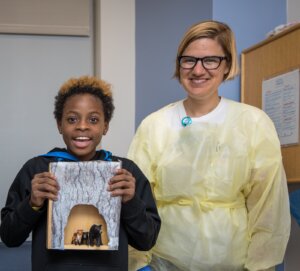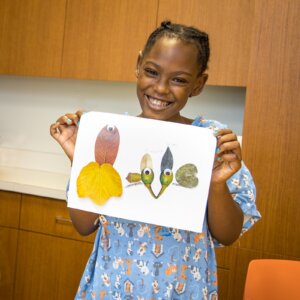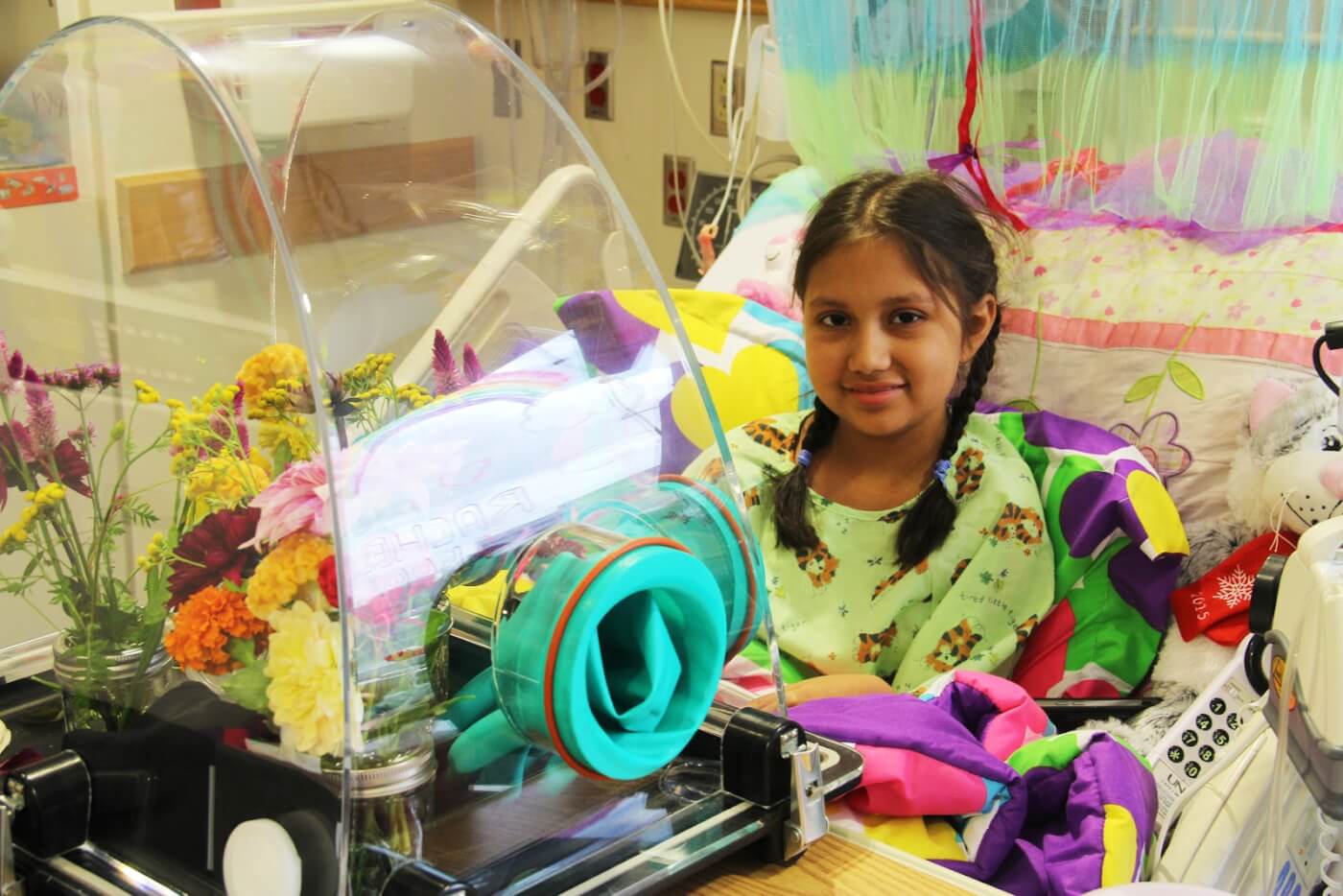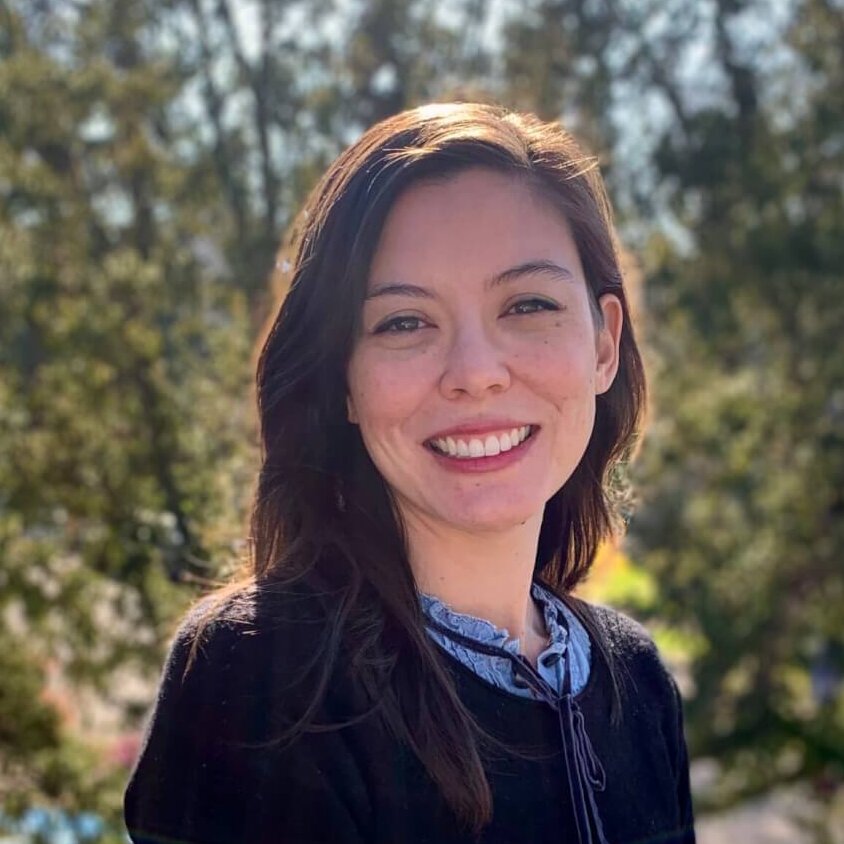Wonder Connection brings nature — and joy — to hospitalized children
Who knew a caterpillar could make such a difference. Rachel*, a pediatric inpatient at UNC Children’s Hospital, was having a rough day. When Wonder Connection founder Katie Stoudemire entered Rachel’s room, the typically outgoing third-grader was sitting in the room with the lights off and a blanket pulled up over her face. “I could barely get her to talk to me,” Stoudemire says when recounting the story. Stoudemire asked Rachel if she wanted to meet some caterpillars, and Rachel responded with a nod. Stoudemire brought in the caterpillars, safely encased inside the WonderSphere — a unique Wonder Connection invention consisting of a sealed chamber with built-in gloves that enables immunocompromised children and teens to plant, dig, water and touch nature without danger of infection.
Rachel put her hands into the gloves to interact with the caterpillars, which were immobile at first. All of a sudden, the caterpillars started to move, crawling on each other and rearing back. Their actions and unpredictability made Rachel laugh out loud. She started asking questions about them, giggling and interacting more with the caterpillars, as well as with the other people in the room. Stoudemire recalls, “She asked about why they were moving the way they were, what they liked eating best and if they could see each other and us. The caterpillars helped change her mood and her day for the better.”

Wonder Connection founder Katie Stoudemire with a proud patient who created a wildlife habitat display. Photo courtesy of Wonder Connection.
This is why Stoudemire founded Wonder Connection, a program which brings hands-on nature and science activities to hospitalized children. Beginning in college, Stoudemire was a regular volunteer at children’s hospitals. Her initial intention was to become a doctor — but her plans changed when she realized that the amount of quality time physicians get to spend with their patients is limited. During her time as a volunteer, she noticed that hospitalized pediatric patients were experiencing heightened stress, fear, anxiety, pain, boredom, isolation from peers and very little interaction with the natural world. So, after getting permission from the hospital, she started bringing natural objects to share with the children and was amazed at the positive results. After several months of grant writing, Wonder Connection was founded in 2006 with a small grant from the Oak Foundation. Wonder Connection is still funded by grants and donations.
“For all of the kids and teens who have lost something by having to be hospitalized, our hope is that our programming helps them find pieces of their childhood — joy, silliness, wonder, connections with plants and animals, making a mess — that they are missing,” Stoudemire explains.

A hospitalized pediatric patient shows off her leaf creatures after participating in Wonder Connection’s natural science programming. Photo courtesy of Wonder Connection.
Wonder Connection programming is backed by science. Research has shown that children in stressful hospital environments improve when they have access to “positive, productive activities that allow the child’s direct involvement in a variety of sensory experiences” (Jessee et al. 1986). Additional findings also indicate that nature experiences help hospitalized children cope emotionally with stress, and that patients who physically interacted with plants experienced a significantly reduced recovery time after medical procedures (Jessee et al. 1987, Raanaas 2010).

A Wonder Connection participant listens to seashells. Photo courtesy of Wonder Connection.
Beyond the mental and physical health benefits that nature and science programming brings, it also increases children’s interest in and understanding of scientific principles. According to research, chronically ill children miss more school and tend to be academic underachievers more often than their peers (Shiu 2001). By exposing pediatric patients to fun science activities, Wonder Connection increases their science competence and builds an enthusiasm for science.
“At this point in time, we have a tiny staff and limited financial resources, so we are focusing on providing the most impactful programming possible for the patients we serve at UNC Hospitals,” Stoudemire explains. “Ultimately, though, our dream is to help children’s hospitals across the country develop similar hands-on natural science programming for their patients.”
*Patient’s name has been changed.
1 Comment
Submit a Comment
-
Network News
POLICY UPDATE: Policy and advocacy for the children and nature movement
-
Voices
Binoculars, bald eagles and my journey as a Black birder
-
Richard Louv
THE WONDER BOWL: Ten Spring and Summer Nature Activities for Kids and Adults
-
Network News
Minneapolis Spotlight: The promise and possibilities of parks for youth
-
Voices
Why nature is my motherhood ally







I wanted o thank you, immensely, for the valuable mission and exceptional communication in launching this mission of bringing nature to children and children to nature.
I also appreciate the languages provided in this site as am preparing a talk to present in Taipei, Taiwan where the field of horticultural therapy for all ages is fully embraced.
The subject I will be speaking on is: Humor in Horticultural Therapy. I would appreciate any resources that you can share with me in overlapping themes such as THE BENEFITS of NATURE & HUMOR. Or how being in nature allows for humor to happen (something we all know intuitively).
Thank you in advance for your support and again, for what you do!
Always,
Libba Shortridge, HTR